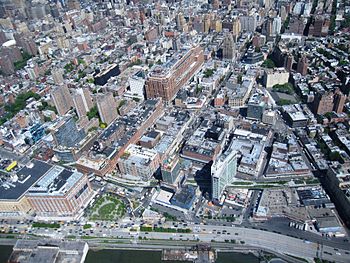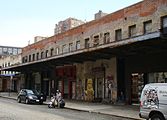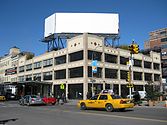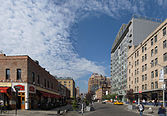- Meatpacking District, Manhattan
-
Coordinates: 40°44′25″N 74°00′25″W / 40.7404°N 74.0070°W
Gansevoort Market Historic District
Location: Roughly bounded by W 16th St., Ninth Ave., and Hudson St., Gansevoort St.; West St. and Eleventh Ave., New York, New York Area: 44 acres (18 ha) Architect: Behrens, Charles; et.al. Architectural style: Greek Revival, Italianate Governing body: State NRHP Reference#: 07000487[1] Added to NRHP: May 30, 2007 "Meatpacking District" redirects here. For the district in Copenhagen, see Meatpacking District, Copenhagen.The Meatpacking District is a neighborhood in the New York City borough of Manhattan which runs roughly from West 14th Street south to Gansevoort Street, and from the Hudson River east to Hudson Street,[2] although recently it is sometimes considered to have extended north to West 16th Street and east beyond Hudson Street.[3]
Contents
History
In 1900, Gansevoort Market was home to 250 slaughterhouses and packing plants,[4] but by the 1980s, it had become known as a center for drug dealing and prostitution, particularly transsexuals. Concurrent with the rise in illicit sexual activity, the sparsely populated industrial area became the focus of the city's burgeoning gay BDSM subculture; loosely embracing the business model of disco impresario David Mancuso, over a dozen sex clubs — including such notable ones as The Anvil, The Manhole, and the heterosexual-friendly Hellfire Club — flourished in the area. At the forefront of the scene was the members-only Mineshaft on Little West 12th Street. A preponderance of these establishments were under the direct control of the Mafia or subject to NYPD protection rackets. In 1985, The Mineshaft was forcibly shuttered by the city at the height of AIDS preventionism.[5]
Beginning in the late 1990s, the Meatpacking District went through a transformation. High-end boutiques catering to young professionals and hipsters opened, including Diane von Furstenberg, Christian Louboutin, Alexander McQueen, Stella McCartney, Theory, Ed Hardy, Puma, Moschino, ADAM by Adam Lippes, Jeffrey New York,the Apple Store; restaurants such as Pastis and Buddha Bar; and nightclubs such as Tenjune, One, G-Spa, Cielo, APT, Level V, and Kiss and Fly. In 2004, New York magazine called the Meatpacking District "New York’s most fashionable neighborhood".[6]
Preservation
By 2003, only 35 of the 250 slaughterhouses and packing plants present a century earlier remained in the area.[4]
In September 2003, after three years of lobbying by the Greenwich Village Society for Historic Preservation, the New York City Landmarks Preservation Commission (LPC) established the Gansevoort Market Historic District.[7] The LPC granted only part of their request: the new district excluded the neighborhood's waterfront, and the restrictions associated with the designation did not apply to the 14-story luxury hotel (the Hotel Gansevoort) which opened in April 2004.[4] In 2007 the Meatpacking District website opened to serve the community and those wanting to know more about the area. The site is intended to provide general news and business information. Also in 2007, GVSHP announced that New York State Parks Commissioner Carol Ash had approved adding the entire Meatpacking District, not just the city-designated Gansevoort Market Historic District, to the New York State and National Registers of Historic Places.[8] The district was listed on the National Register on May 30, 2007, with 140 buildings, two structures, and one other site included.[1]
In June 2009, the first segment of the High Line linear park, a former elevated freight railroad built under the aegis of Robert Moses, opened to great reviews in the District and the southern portion of Chelsea to the north as a greenway modeled after Paris' Promenade Plantée. Thirteen months earlier, the Whitney Museum of American Art announced it would build a second, Renzo Piano-designed home on Gansevoort Street, just west of Washington Street and the southernmost entrance to the High Line.
Also in 2009, developers proposed a glass-walled office tower and retail space for 437 West 13th Street that was larger than zoning allowed. The Greenwich Village Society for Historic Preservation strongly opposed the project, as increasing the scale of buildings in the area the sense of openness in the area would be diminished and the low-scale character of the neighborhood would be eroded.[9] In the end, the developers were not granted all of the variances that they had hoped for, but a glass tower will be built.
In October 2010, after over two years of campaigning by the Greenwich Village Society for Historic Preservation and other community groups[10], the C6-1 Rezoning was passed in the area bound by Greenwich, Washington, West 10th, and West 12th Streets.[11] It imposed an 80-foot height limit and ended commercial bonuses for hotels, both of which will help the continued preservation of the area.
Gallery
-
Before gentrification, many meatpacking buildings had become derelict
-
The Herring Safe & Lock Company Building (1849) at the intersection of Ninth Avenue and Hudson Street at 14th Street
-
Hotel Gansevoort (right) and Pastis (left) on Ninth Avenue
-
The Standard Hotel above the High Line
See also
References
- Notes
- ^ a b "National Register Information System". National Register of Historic Places. National Park Service. 2009-03-13. http://nrhp.focus.nps.gov/natreg/docs/All_Data.html.
- ^ McPherson, Coco (December 24, 2002). "Close-Up on: The Meatpacking District". Village Voice. http://www.villagevoice.com/nyclife/0252,mcpherson,40756,15.html. Retrieved 2008-02-28.
- ^ Mohney, Chris (September 25, 2006). "Close-Up on: The Meatpacking District". Gawker. http://gawker.com/news/meatpacking-district/hit-piece-meatpacking-district-202992.php. Retrieved 2008-02-28.
- ^ a b c New York City Names Gansevoort Market a Historic District, from the website of the National Trust for Historic Preservation
- ^ Gay, Tim (July 14 - 20, 2004). "Bring back the beefcake, and add some flowers too". The Villager. http://www.thevillager.com/villager_63/bringbackthebeefcake.html. Retrieved 2011-08-12.
- ^ Steinberg, Jon (August 18, 2004). "Meatpacking District Walking Tour". New York. http://nymag.com/visitorsguide/neighborhoods/meatpacking.htm. Retrieved 2008-02-28.
- ^ Greenwich Village Society for Historic Preservation Save Gansevoort Market
- ^ Greenwich Village Society for Historic Preservation Meatpacking District Approved for Listing on State and National Register of Historic Places (11 April 2007)
- ^ Greenwich Village Society for Historic Preservation[1]
- ^ Greenwich Village Society for Historic Preservation[2]
- ^ Stoelker, Tom (November 17, 2010). "Massive Projects Zoned Out of the Village". The Architect's Newspaper. http://archpaper.com/news/articles.asp?id=4999. Retrieved 2011-08-12.
External links
Categories:- Historic districts in New York
- Neighborhoods in Manhattan
- Warehouse districts of the United States
- Historic districts in New York City
- Economy of New York City
-
Wikimedia Foundation. 2010.







